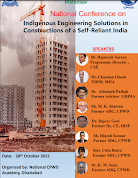Sustainable Construction-Issues and Solutions
This blog does not involve complicated simulations. Instead, it attempts to identify sustainability issues in the Indian urban development context. All constructions are bad for the environment— considering our immense shortage we ought to build in a big way— but our building activities must show this sensitivity.
Transdisciplinary work on Evaluating Ecosystem Services provided by a small bird sanctuary in the Delhi NCR led to the successful defence of my doctoral thesis early this year. Ecosystem Services (ES) are the many benefits that Human's derive from Ecosystems is thus directly related to human Habitats. Measuring and accounting ES in the context of Urban Development decisions seems prudent. Unfortunately, a vast majority of our practicing Architects and Engineers seem unaware of these fast developments.
As a policy driver, the governments play the lead role in adapting & mitigating climate change and sustainable development. I can't imagine a candidate preparing for civil services examination who is not aware of Sustainable Development Goals (SDGs) or an Architect or a Civil Engineer appearing for Group 'A' services for Civil Engineers and Architects does not know about sustainability practices of National Building Code.
However, ignorance about SDGs at the top level of the government bureaucrats seem to match the lack of understanding of top Construction professionals about sustainability principles of the National Building Code. Please don't be surprised if the top Government Architect/Engineer is unaware as when she/he cleared the UPSC these provisions were non-existent. No wonder, Indian Smart Cities discourse, driven by corporate IT companies are lacking in addressing sustainability and community issues. Issues related to Green Building ratings are the next on the discussion agenda.
The nongovernmental Green Building rating systems that took off with policy and direct government support in the first decade of this millennium faired better. The sinking of the construction industry to new lows nonetheless got better over them. The business model based on grabbing, squatting and monopolising policy freebees set in. Entropy comes easy. Many local bodies soon realized this and allowed benefits for rooftop solar and water conservation etc. without their intervention and rent-seeking. One size does not fit all: local priorities must trump over monopolies.
The two relatively newly launched rating systems — by an NGO and other by the government thus raise new hopes. How would these differentiate and add value is the question?
An (integrative) sustainability review of all design documents as identified by the NGO is potentially game-changing. Case studies can showcase how transdisciplinarity in a model of win-wins create value for all stakeholders. How fast our fragmented professional institutions can create such transdisciplinary teams is the question? The government recruits the best young transdisciplinary professionals including Architects and Engineers — whether their top brass would understand this fundamental would determine its success. The NBC in the part '0' introduced in 2005 declared an integrative approach as a prerequisite for applying the code. Part-11 " Approach to Sustainability" added in 2011 reiterated the importance of an integrative approach. This fundamental still remains on paper. A Local and Contextual matrix based on NBC's part -11 is what should determine the green rating.
Climate change is creating unprecedented extreme events. As the knowledge and interconnectedness of human habitats within the wider natural ecosystems increases, the integrative transdisciplinary project 'Green Buildings" teams should additionally answer:
- How is it addressing the disaster resilience of Indian infrastructure?
- How is it contributing to India's commitments to Nationally Determined Contributions (NDCs)?
- How is it supporting SDGs?



The issues are flagged and focus areas identified. Hope policy makers take note of issues and nudge the policy framework to meet the objective. My best compliments.
ReplyDeleteThanks! Your positive review is valuable.
DeleteEnsuring that all new infra is made as disaster resilient and to upgrade existing or retrofit them to ensure that they are able to resist EWE is a difficult task. particularly as most people who are promoting these are unaware of the risks and are shy to make the necessary additional expenditure or efforts. We may not be able to prevent the EWEs but we can ensure that we come out safe or with minimum loss. Pandemics, like the current ones, of course, pose different challenges. Here it is just the inadequacy of healthcare infra which has been exposed. Nobody could have foreseen the sharp rise during second wave of Covid. Now, however, having seen it we need to rethink hospital designs. This has, some, resemblance to NBC threats. With some application we should be able to address future situations. For other natural disasters design interventions and better urban planning is the need. Hope professionals will be able to address the issues.
ReplyDeleteThank You Sir, for adding to the context, comprehension and comprehensiveness. Your idea of retrofitting to minimize losses is appropriate, we can examine and retrofit each structure case by case.
DeleteSustainable construction aims to create environmentally-friendly and energy-efficient buildings that consume fewer resources and emit less pollution. However, it faces several challenges, such as high initial costs, lack of awareness, and regulatory barriers. To overcome these challenges, builders can use green materials, adopt energy-efficient designs, and embrace sustainable construction practices such as recycling and reducing waste. Governments can also incentivize sustainable construction by providing tax benefits, subsidies, and certifications for green buildings. Overall, sustainable construction is crucial for protecting the environment, reducing energy consumption, and improving public health. I also remember the Top Civil Engineering Companies In Chennai also provides a professional service similar to this.
ReplyDelete